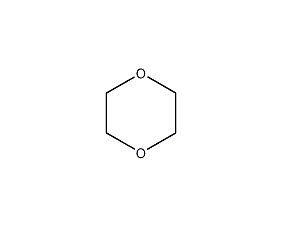
Structural formula
| Business number | 03HC |
|---|---|
| Molecular formula | C4H8O2 |
| Molecular weight | 88.11 |
| label |
1,4-dioxane, 1,4-dioxane, dioxane, 1,4-dioxane, Glycol diether, Diethylene oxide, Dioxane, 1,4-Dioxacyclohexane, Dithylene dioxide, p-Dioxane, 1,4-Diethylenedioxide, Dehydrating solvents for organic synthesis, Lignin extractant, fumigation disinfectant, Ether and acetal solvents |
Numbering system
CAS number:123-91-1
MDL number:MFCD00006571
EINECS number:204-661-8
RTECS number:JG8225000
BRN number:102551
PubChem number:24857850
Physical property data
1. Properties: colorless, transparent liquid with an ether smell. [1]
2. Melting point (℃): 11.8[2]
3. Boiling point (℃): 101.3 [3]
4. Relative density (water = 1): 1.04[4]
5. Relative vapor density (Air=1): 3.03[5]
6. Saturated vapor pressure (kPa): 4.1 (20℃)[6]
7. Heat of combustion (kJ/mol): -2428.6[7]
8. Critical temperature (℃): 312[8]
9. Critical pressure (MPa): 5.14[9]
10. Octanol/water partition coefficient: -0.27 [10]
11. Flash point (℃): 12 (CC); 18.3 (OC) [11]
12. Ignition temperature (℃): 180[12]
13. Explosion limit (%): 22.2[13]
14. Lower explosion limit (%): 2.0[14]
15. Solubility: miscible with water and most organic solvents. [15]
16. Refractive index (n20ºC): 1.4229
17. Refractive index (n25ºC): 1.4203
18 . Viscosity (mPa·s, 20ºC): 1.3
19. Viscosity (mPa·s, 25ºC): 1.2
20. Viscosity (mPa·s, 30ºC): 1.087
21. Flash point (ºC, closed): 12.2
22. Flash point (ºC, open): 15.6
23. Fire point (ºC): 180
24. Heat of evaporation (KJ/mol): 35.80
25. Heat of fusion (KJ/mol): 12.5
26. Specific heat capacity (KJ/( kg·K), 20ºC): 1.72
27. Conductivity (S/m, 25ºC): <2×10-8
28. Body expansion coefficient (K-1, 20ºC): 0.001030
29. Body expansion coefficient (K-1, 0~55ºC): 0.001070
30. Volume expansion coefficient (K-1, 55ºC): 0.00113
31. Relative density (25℃, 4℃): 1.0281
32. Critical density (g·cm-3): 0After frequent urination, the urine decreases and eventually stops urinating. At the same time, urea in the blood increases, leading to drowsiness, lethargy, and death after 2 to 3 days. Long-term exposure or inhalation of its vapor can irritate the eyes, nose, throat and lungs, and damage the liver, kidneys, brain and skin. The maximum allowable concentration in the workplace is 360mg/m3. When it exceeds 720mg/m3, it can cause symptoms such as headache and stomachache. Dioxane can be absorbed through the skin and cause poisoning. When in contact with the skin, rinse with plenty of water and wash with soap.
4. Stability[25] Stable
5. Incompatible substances[26] Strong oxidants, strong reducing agents, halogens
6. Conditions to avoid contact [27] Light, contact with air
7. Hazards of aggregation[28] No aggregation
Storage method
Storage Precautions[29] Stabilizers are usually added to products. Store in a cool, ventilated warehouse. Keep away from fire and heat sources. The storage temperature should not exceed 37°C. The packaging must be sealed and must not come into contact with air. They should be stored separately from oxidants, reducing agents and halogens, and avoid mixed storage. It should not be stored for a long time to avoid deterioration. Use explosion-proof lighting and ventilation facilities. It is prohibited to use mechanical equipment and tools that are prone to sparks. The storage area should be equipped with emergency release equipment and suitable containment materials.
Synthesis method
Refining method: The main impurities are acetaldehyde, 2-methyl-1,3-dipentane, acetal, peroxide and moisture. When the impurity content is not large, metallic sodium can be added to reflux for 6 to 12 hours and then distilled directly. When containing a large amount of acetal, hydrolysis is required. Add 27 mL of concentrated hydrochloric acid and 200 mL of water to 2 L of dioxane and reflux for 12 hours. During the reflux process, diffuse nitrogen to remove the generated acetaldehyde; after cooling, add solid potassium hydroxide until it is no longer dissolved. Separate the water layer, add potassium hydroxide and dry for 24 hours. The preliminarily dried dioxane plus metallic sodium is refluxed for 6 to 12 hours, and then distilled in the presence of metallic sodium. Peroxide removal is the same as for diethyl ether. Add crushed sodium hydroxide to industrial dioxane to remove acidic substances and moisture. After filtering out the solid matter, distill it to obtain pure dioxane.
1. Ethylene glycol is obtained by dehydration under the catalysis of sulfuric acid. The reaction formula is as follows:
![]()
2. Ethylene oxide is obtained by direct dimerization. The reaction formula is as follows:
![]()
The above dimerization reaction is carried out in the presence of an acidic catalyst, and the catalyst can be sulfuric acid Sodium hydrogen, sulfuric acid and boron trifluoride, etc. When industrial-grade dioxane needs to be refined into a pure product, powdered sodium hydroxide can be added to the dioxane to remove acidic substances and moisture, filter out the solid matter and then distill it to obtain the finished product.
3. Diethylene glycol method The main reaction of intramolecular dehydration of diethylene glycol under the action of protic acid to produce dioxane is as follows:
![]()
Purpose
1. Used as a solvent for nitrocellulose, celluloid, cellulose resin, vegetable oil, mineral oil and oil-soluble dyes. It is also used in the manufacture of spray paints, varnishes, plasticizers, wetting agents, polishes, paint strippers, spices, preservatives, fumigants, deodorants and medical supplies. In addition, it is also used as a lignin extractant and to extract and separate lithium from sodium, potassium, and lithium chlorides.
2. Solvents for chromatographic analysis and commonly used solvents for non-aqueous titrations. It is also a solvent for cellulose acetate and its derivatives.
3. Used as solvent, emulsifier, and detergent. [30]

 微信扫一扫打赏
微信扫一扫打赏

